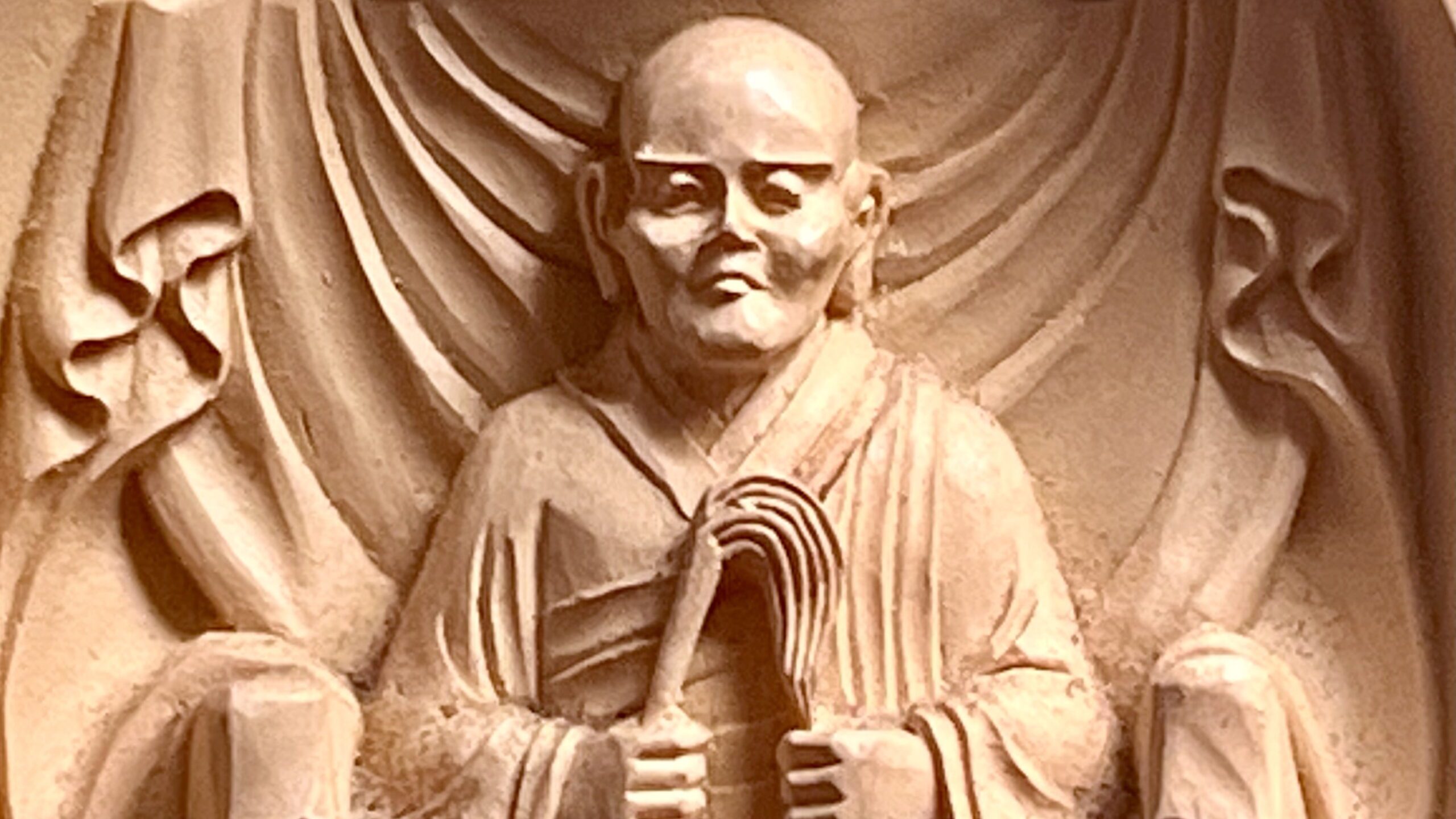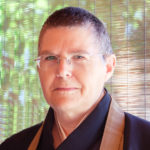To study the Buddha Way is to study the self. To study the self is to forget the self. To forget the self is to be verified by all things. To be verified by all things is to let the body and mind of the self and the body and mind of others drop off. There is a trace of realization that cannot be grasped. We endlessly express this ungraspable trace of realization. —Eihei Dogen
Dogen clearly states that the study of this dharma called the self, if investigated through the lens of the Buddha Way, will lead to awakening. This self, when illuminated, reveals the true relationship between self and other. Dogen calls this dropping off body-mind of self and other. Realized action is validated by all parties when we are freed of dualistic notions of self versus other. Both sides can function in accord. You can’t label this experience when you are in the middle of it, but we might call it mutual interconnected process continuing without end.
In Shobogenzo “Jisho-zanmai” (Samadhi as Experience of the Self), Dogen again points to the importance of studying the self as a Dharma gate to awakening:
“To take up the hundred weeds is to take up the self. To take up the ten thousand trees is to take up the self. We learn in practice that the self is inevitably efforts like these. In this learning in practice, we get rid of the self, and we experience the self as exact accordance.”
And later in the same text,
“If we exhaustively explore the self, we will already have exhaustively explored the external world. And if we exhaustively explore the external world, we will already have exhaustively explored the self. Unless received from a master, this Buddhist standard cannot be realized in bodily experience.”
To study the Buddha Way is to study the self.
What is the relationship between “when one side is illuminated, the other is dark,” or a deep investigation of one thing, and “to study the Buddha Way is to study the self”? Perhaps the most important point of this line is that we study the self rather than studying someone else. This is to focus on the nature of ourselves, which will open up the true nature of all being(s).
Quoting Shobogenzo “Gabyo” (A Painted Rice Cake), Dogen clearly makes the connection between the deep study of one thing and the understanding of all things:
“Thus, it has been said [by Yun-chu], ‘If you understand one thing even a little, you understand all things.’ … When under-standing one thing does not obstruct understanding all things, this is understanding both one thing and all things.”
While studying the self from a Western psychological perspective may be quite helpful, Dogen is specifically talking about using Buddhist tenets and methods for awakening. His teaching is in some sense an application of the Huayan teachings on mutual penetration and identity to the self. We study the self and thus know this one thing, but we don’t stop there, because if we really do penetrate the “one thing,” we realize “all things.”
Still, we will have to hold both what is seen (illuminated) and what we cannot immediately see (dark). This nonperceptual perception is intimately knowing and responding to what is presencing at this time. At the same time, when we realize and act upon our sameness, we recognize that each dharma (person, situation, and so forth) has its own particularity. That too is part of the equation of awakening.
How do we actually study the self in the Buddha Way? Much of the rest of “Genjokoan” explores this question. The first step in studying the Buddha Way is to look at ourselves but in a very specific context as elucidated in the opening lines of “Genjokoan”: “When all dharmas are the Buddha Dharma, there is delusion and realization, practice, life and death, buddhas and living beings. When the ten thousand dharmas are without [fixed] self, there is no delusion and no realization, no buddhas and no living beings, no birth and no death.”
Studying the Buddha Way is both the practice of the Buddha Way as well as the learning of the Buddha Way. Both arise hand in hand. Nevertheless, learning can be parsed as having different aspects: intellectual, observational, practice, and intuition. If you are reading this book, you are making the effort to understand the Buddha Dharma as Dogen understood it and to apply that learning to your practice.
My initial introduction, as an American Zen student, to understanding the nature of dharmas and self was through studying the Heart Sutra, which we recited almost daily. In this sutra we read, “Form is emptiness, emptiness is form, form itself is emptiness and emptiness itself is form.” Because the Heart Sutra is difficult to understand, we begin by intellectually decoding these teachings. As we integrate intellectual with intuitive understanding into our practice, we begin to observe the veracity of the teaching and to respond to our life through that lens. Intuitive understanding reflects the experiences we have had outside the intellect, yet under- standing may also be dependent upon intellectual study to clarify what we intuit. We can think of intellect, observation, practice, and intuition as all functioning simultaneously within the context of what is needed. So, we should not think that intellectual study is bad and intuitive response is always good, or vice versa. All four aspects function together: intellectual, observational, practice, and intuition. This inquiry is done through the self’s perception, under- standing, and practice.
As we study the teachings of Buddhism, we find out about the self’s true nature and place in the world of dharmas. We come to see that we are impermanent and inter-being with all of reality. We are one with reality as part of a great process of becoming, and we are at the same time a particular being or dharma. Through this investigation we realize the meaning of studying the self. We may not believe it at first, but we go forward with faith in these teachings.
We may ask, “Who am I? How do I function in this vast mandala called reality?” We ask the questions that Dogen presents: “What is delusion? What is realization? How do I approach practicing the Dharma? What is my birth and death in the Buddhist context? Am I a buddha and/or a living being? How does my understanding bring about transformation?” All of these questions may arise, and all of them will be offered in relationship to our own practice and our own view of self.
These questions become folded into our practice in a seamless way. Shohaku Okumura writes of study,
“Even when we say, ‘I study the Buddha Way,’ there is still a subject and an object that are separate. …When we truly practice the Buddha Way or study the self, there is no separation between ‘I,’ ‘the self,’ ‘the Buddha Way,’ ‘study,’ and ‘practice.’…Yet when we think or speak, we use concepts and we must there- fore say, “I study the self,” or “I study the Buddha Way.” So the important point is that we should just study and just practice.”
As we study, observe, and practice the Buddhist doctrine concerning the absence of a separate, disconnected self operating outside the realm of causality, we begin to respond to our situation with greater intuition and intimacy. This is when study becomes practice. We begin to know that what is not revealed is contiguous with what is seen. Through that inquiry we begin to understand the second sentence of the opening: “When the ten thousand dharmas are without [fixed] self, there is no delusion and no realization, no buddhas and no living beings, no birth and no death.”
But we cannot reach this understanding without entering the Dharma gate of the duality of our own experience.
To study the self is to forget the self.
Engaging in this study, we begin to see the truth of our not-separateness. Yet this can be a tricky idea because the self is still a particular self. You are you, not the other, yet you are also not different from the other. Dogen refers to this relationship in “Uji” (Being-Time): “I encounter a man. A man encounters a man. I encounter myself. Going forth encounters going forth.” Each person or each thing connects with another particular person or thing. We can see each other in each other because we are the same and, at the same time, we do not lose the independent aspect of a person or dharma. In that exchange or inter-being, I see myself. Life’s presencing cofunctions with life’s presencing.
When we are able to manifest this practice, which is not different from studying the Buddha Way, we have forgotten the self. A forgotten self is the self that no longer perceives itself as the center of the universe but rather as one of the many elements of the universe. In the “Uji” quotation above, Dogen is describing the intimacy of such an encounter as “going forth encounters going forth.”
Seeing yourself as the universe does not mean you are some kind of demigod who makes the world. Rather, you make the world in concert with the whole of the world, and you are not separate from that world’s making. In that relationship arises responsibility for your actions in accord (or discord) with others.
Senne says something interesting and seemingly opaque here when he writes, “To forget means to know without touching things.” He does not elaborate on the meaning of his comment, but “to know without touching things” may refer to a state in which one knows and responds to others or a situation without needing to verbally assess what is needed. This would be a state of forgetting the self.
To forget the self is to be verified by all things. To be verified by all things is to let the body and mind of the self and the body and mind of others drop off.
Forgetting the self results in “buddhas [who] are truly buddhas [but don’t] perceive they are buddhas.” Having forgotten, dropped, or let go of the mistaken idea that we are separate entities disconnected from the world’s inter-being, we can then be verified by the world itself. This does not require that we self-consciously acknowledge our realization. In fact, realization is predicated upon forgetting realization as a separate thing. Dogen defines verified as “to let the body and mind of the self and the body and mind of others drop off.” Sho, translated here as “verified,” can also be translated as “confirmed” or “enlightened.”
From this point of view, we understand that to be verified does not mean that things or persons come up to you and say, “Well done. You’re great. I verify your realization.” It means that as we are integrated with the totality of our life, our situation, our dharma position, we cease to only view those we encounter as others to be manipulated or used. We see ourselves and others as integrated, whole beings in concert making something happen. This is dropping body and mind.
Dogen describes how this looks in “Yuibutsu Yobutsu” (Only a Buddha and a Buddha):
“How, then, are we to understand that this state of buddha is the same as us? To begin with, we should understand the action of buddha. The action of buddha takes place in unison with the whole Earth and takes place together with all living beings. If it does not include all, it is never the action of buddha. Therefore, from the establishment of the mind until the attainment of realization, both realization and practice are inevitably done together with the whole Earth and together with all living beings.”
And in the same section he writes, “The human being under investigation is not I and is not [another] person.”
If we push forward our small self’s agenda, thinking that we are practicing Buddha’s Way, we are mistaken. When we meet everything with an open and spacious mind, with the knowledge that we are one process functioning, then we are practice-realizing together as all beings. This is the same activity as dropping body and mind.
From Meeting the Myriad Things © 2025 by Shinshu Roberts, with contributions by Shohaku Okumura and Zuiko Redding. Reprinted in arrangement with Shambhala Publications, Inc. Boulder, CO. www.shambhala.com.


